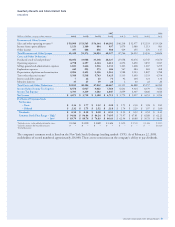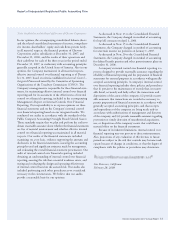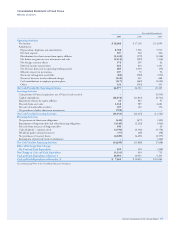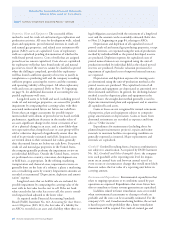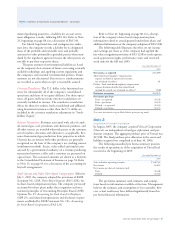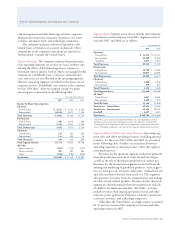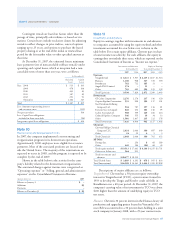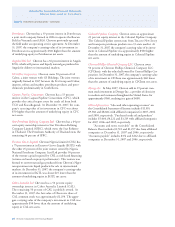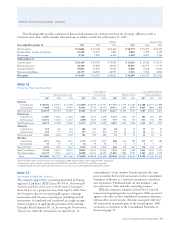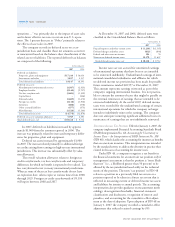Chevron 2007 Annual Report Download - page 63
Download and view the complete annual report
Please find page 63 of the 2007 Chevron annual report below. You can navigate through the pages in the report by either clicking on the pages listed below, or by using the keyword search tool below to find specific information within the annual report.
61
mineral producing properties, a liability for an asset retire-
ment obligation is made, following FAS 143. Refer to Note
23, beginning on page 84, for a discussion of FAS 143.
For federal Superfund sites and analogous sites under
state laws, the company records a liability for its designated
share of the probable and estimable costs and probable
amounts for other potentially responsible parties when man-
dated by the regulatory agencies because the other parties are
not able to pay their respective shares.
The gross amount of environmental liabilities is based
on the company’s best estimate of future costs using currently
available technology and applying current regulations and
the company’s own internal environmental policies. Future
amounts are not discounted. Recoveries or reimbursements
are recorded as assets when receipt is reasonably assured.
Currency Translation The U.S. dollar is the functional cur-
rency for substantially all of the company’s consolidated
operations and those of its equity affiliates. For those opera-
tions, all gains and losses from currency translations are
currently included in income. The cumulative translation
effects for those few entities, both consolidated and affiliated,
using functional currencies other than the U.S. dollar are
included in the currency translation adjustment in “Stock-
holders’ Equity.”
Revenue Recognition Revenues associated with sales of crude
oil, natural gas, coal, petroleum and chemicals products, and
all other sources are recorded when title passes to the customer,
net of royalties, discounts and allowances, as applicable. Rev-
enues from natural gas production from properties in which
Chevron has an interest with other producers are generally
recognized on the basis of the company’s net working interest
(entitle ment method). Excise, value-added and similar taxes
assessed by a governmental authority on a revenue- producing
transaction between a seller and a customer are presented on
a gross basis. The associated amounts are shown as a footnote
to the Consolidated Statement of Income on page 54. Refer
to Note 13, on page 69, for a discussion of the accounting for
buy/sell arrangements.
Stock Options and Other Share-Based Compensation Effective
July 1, 2005, the company adopted the provisions of FASB
Statement No. 123R, Share-Based Payment (FAS 123R), for
its share-based compensation plans. The company previously
accounted for these plans under the recognition and mea-
surement principles of Accounting Principles Board (APB)
Opinion No. 25, Accounting for Stock Issued to Employees
(APB 25), and related interpretations and disclosure require-
ments established by FASB Statement No. 123, Accounting
for Stock-Based Compensation (FAS 123).
Refer to Note 21, beginning on page 80, for a descrip-
tion of the company’s share-based compensation plans,
information related to awards granted under those plans and
additional information on the company’s adoption of FAS 123R.
The following table illustrates the effect on net income
and earnings per share as if the company had applied the
fair-value recognition provisions of FAS 123R to stock options,
stock appreciation rights, performance units and restricted
stock units for the full year 2005.
Year ended December 31
2005
Net income, as reported $ 14,099
Add: Stock-based employee compensation
expense included in reported net income,
net of related tax effects 81
Deduct: Total stock-based employee compensation
expense determined under fair-valued-based
method for awards, net of related tax effects* (108)
Pro forma net income $ 14,072
Net income per share:
Basic – as reported $ 6.58
Basic – pro forma $ 6.56
Diluted – as reported $ 6.54
Diluted – pro forma $ 6.53
*
Fair value determined using the Black-Scholes option-pricing model.
In August 2005, the company acquired Unocal Corporation
(Unocal), an independent oil and gas exploration and pro-
duction company. The aggregate purchase price of Unocal was
$17,288. The final purchase-price allocation to the assets and
liabilities acquired was completed as of June 30, 2006.
The following unaudited pro forma summary presents
the results of operations as if the acquisition of Unocal had
occurred at the beginning of 2005:
Year ended December 31
2005
Sales and other operating revenues $ 198,762
Net income 14,967
Net income per share of common stock
Basic $ 6.68
Diluted $ 6.64
The pro forma summary used estimates and assump-
tions based on information available at the time. Management
believes the estimates and assumptions to be reasonable; how-
ever, actual results may have differed significantly from this
pro forma financial information.


